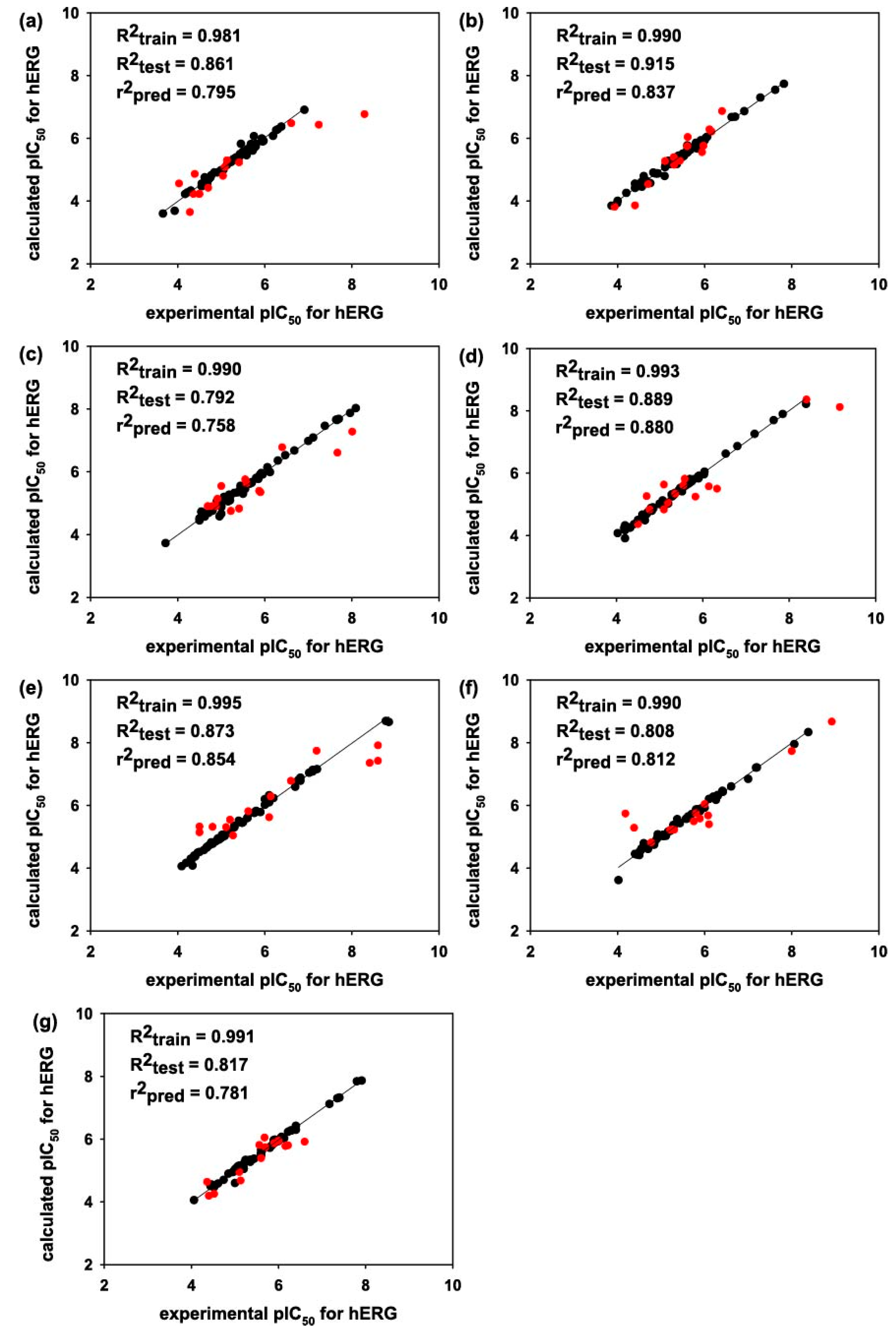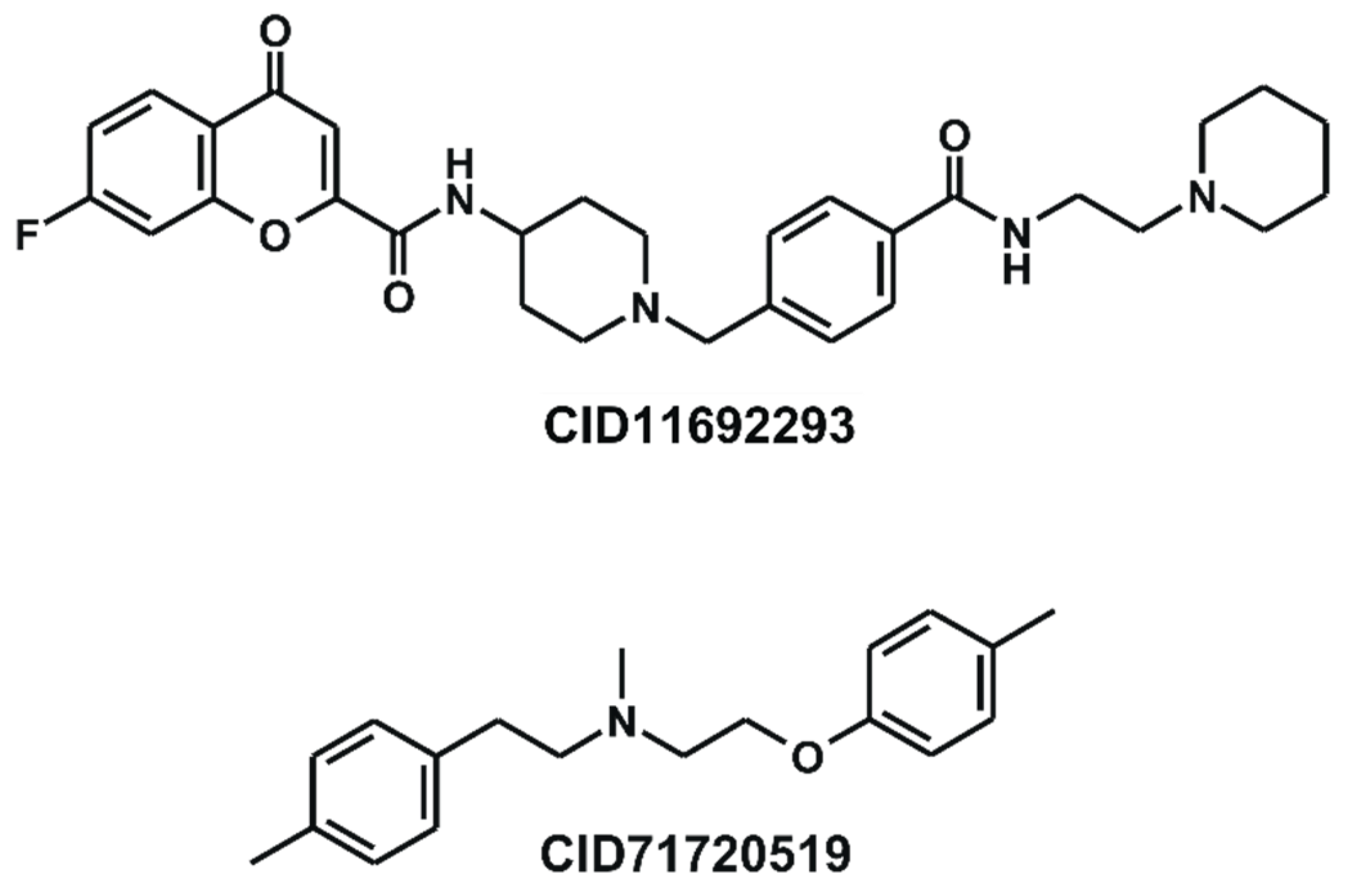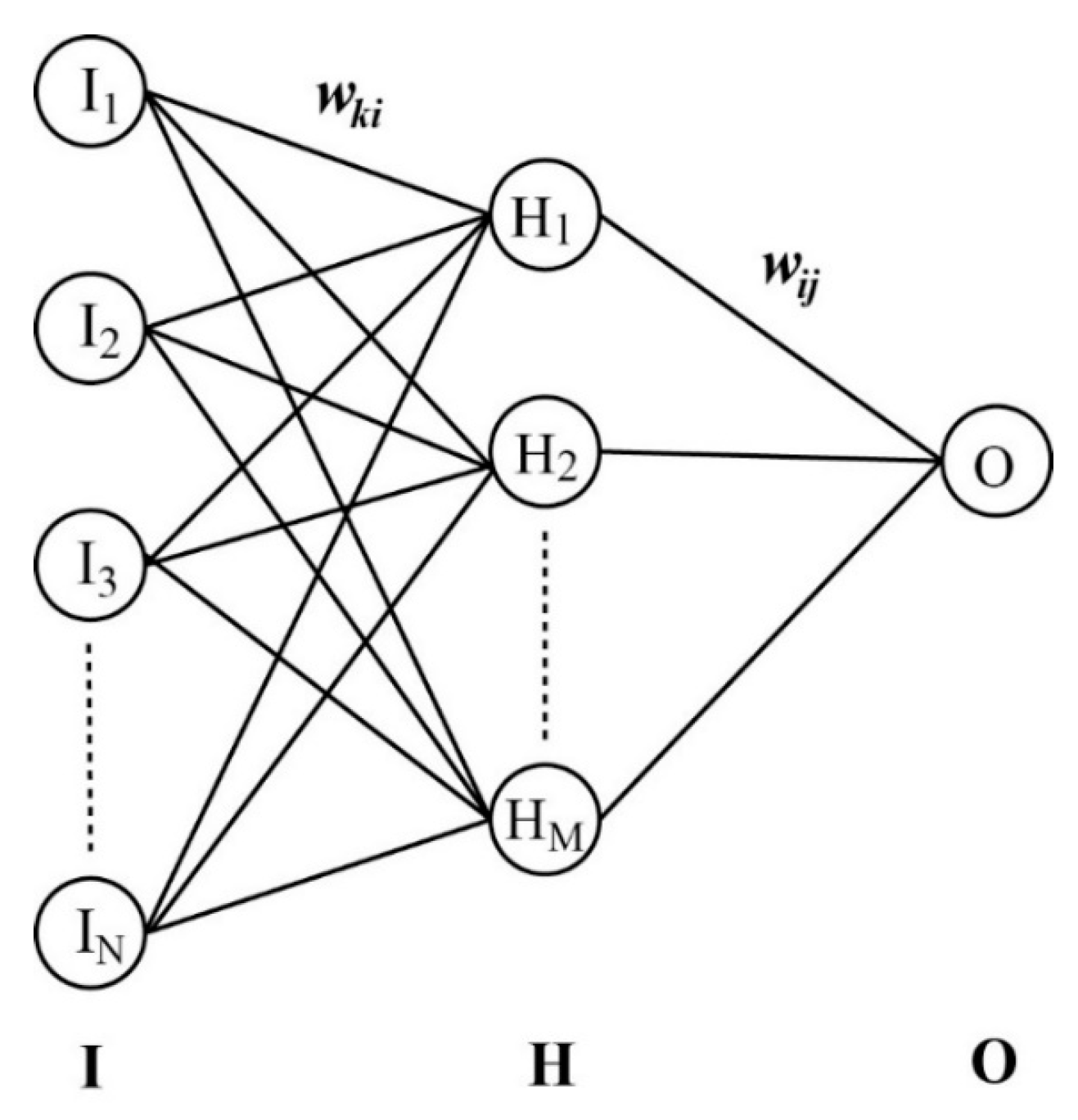Derivation of Highly Predictive 3D-QSAR Models for hERG Channel Blockers Based on the Quantum Artificial Neural Network Algorithm
Abstract
1. Introduction
2. Results and Discussion
3. Materials and Methods
3.1. Preparation of the Molecular Dataset for hERG Channel Binders
3.2. Pairwise 3D Structural Alignments of the Molecules in the Dataset
3.3. Calculations of the 3D Molecular Descriptors
3.4. Derivation of the Prediction Models for the Activities of hERG Blockers
4. Conclusions
Supplementary Materials
Author Contributions
Funding
Institutional Review Board Statement
Informed Consent Statement
Data Availability Statement
Acknowledgments
Conflicts of Interest
References
- Helliwell, M.V.; Zhang, Y.; Harchi, A.E.; Dempsey, C.E.; Hancox, J.C. Inhibition of the hERG potassium channel by a methanesulphonate-free E-4031 analogue. Pharmaceuticals 2023, 16, 1204. [Google Scholar] [CrossRef] [PubMed]
- De Bruin, M.L.; Pettersson, M.; Meyboom, R.H.B.; Hoes, A.W.; Leufkens, H.G.M. Anti-HERG activity and the risk of drug-induced arrhythmias and sudden death. Eur. Heart J. 2005, 26, 590–597. [Google Scholar] [CrossRef] [PubMed]
- Zhou, Z.; Vorperian, V.R.; Gong, Q.; Zhang, S.; January, C.T. Block of HERG potassium channels by the antihistamine astemizole and its metabolites desmethylastemizole and norastemizole. J. Cardiovasc. Electrophysiol. 1999, 10, 836–843. [Google Scholar] [CrossRef] [PubMed]
- Mamoshina, P.; Rodriguez, B.; Bueno-Orovio, A. Toward a broader view of mechanisms of drug cardiotoxicity. Cell Rep. Med. 2021, 2, 100216. [Google Scholar] [CrossRef]
- Paakkari, I. Cardiotoxicity of new antihistamines and cisapride. Toxicol. Lett. 2002, 127, 279–284. [Google Scholar] [CrossRef]
- Brown, A.M. Drugs, hERG and sudden death. Cell Calcium 2004, 35, 543–547. [Google Scholar] [CrossRef]
- Raschi, E.; Vasina, V.; Poluzzi, E.; De Ponti, F. The hERG K+ channel: Target and antitarget strategies in drug development. Pharmacol. Res. 2008, 57, 181–195. [Google Scholar] [CrossRef]
- Finlayson, K.; Turnbull, L.; January, C.T.; Sharkey, J.; Kelly, J.S. [3H]dofetilide binding to HERG transfected membranes: A potential high throughput preclinical screen. Eur. J. Pharmacol. 2001, 430, 147–148. [Google Scholar] [CrossRef]
- Bell, D.C.; Fermini, B. Use of automated patch clamp in cardiac safety assessment: Past, present and future perspectives. J. Pharmacol. Toxicol. Methods 2021, 110, 107072. [Google Scholar] [CrossRef]
- Cheng, C.S.; Alderman, D.; Kwash, J.; Dessaint, J.; Patel, R.; Lescoe, M.K.; Kinrade, M.B.; Yu, W. A high-throughput HERG potassium channel function assay: An old assay with a new look. Drug Dev. Ind. Pharm. 2002, 28, 177–191. [Google Scholar] [CrossRef]
- Polak, S.; Wiśniowska, B.; Brandys, J. Collation, assessment and analysis of literature in vitro data on hERG receptor blocking potency for subsequent modeling of drugs’ cardiotoxic properties. J. Appl. Toxicol. 2009, 29, 183–206. [Google Scholar] [CrossRef]
- Delre, P.; Lavado, G.J.; Lamanna, G.; Saviano, M.; Roncaglioni, A.; Benfenati, E.; Mangiatordi, G.F.; Gadaleta, D. Ligand-based prediction of hERG-mediated cardiotoxicity based on the integration of different machine learning techniques. Front. Pharmacol. 2022, 13, 951083. [Google Scholar] [CrossRef] [PubMed]
- Ryu, J.Y.; Lee, M.Y.; Lee, J.H.; Lee, B.H.; Oh, K.S. DeepHIT: A deep learning framework for prediction of hERG-induced cardiotoxicity. Bioinformatics 2020, 36, 3049–3055. [Google Scholar] [CrossRef] [PubMed]
- Karim, A.; Lee, M.; Balle, T.; Sattar, A. CardioTox net: A robust predictor for hERG channel blockade based on deep learning meta-feature ensembles. J. Cheminformatics 2021, 13, 60. [Google Scholar] [CrossRef] [PubMed]
- Cai, C.; Guo, P.; Zhou, Y.; Zhou, J.; Wang, Q.; Zhang, F.; Fang, J.; Cheng, F. Deep learning-based prediction of drug-induced cardiotoxicity. J. Chem. Inf. Model. 2019, 59, 1073–1084. [Google Scholar] [CrossRef] [PubMed]
- Wacker, S.; Noskov, S.Y. Performance of machine learning algorithms for qualitative and quantitative prediction drug blockade of hERG1 channel. Comput. Toxicol. 2018, 6, 55–63. [Google Scholar] [CrossRef] [PubMed]
- Kalyaanamoorthy, S.; Barakat, K.H. Development of safe drugs: The hERG challenge. Med. Res. Rev. 2018, 38, 525–555. [Google Scholar] [CrossRef] [PubMed]
- Creanza, T.M.; Delre, P.; Ancona, N.; Lentini, G.; Saviano, M.; Mangiatordi, G.F. Structure-based prediction of hERG-related cardiotoxicity: A benchmark study. J. Chem. Inf. Model. 2021, 61, 4758–4770. [Google Scholar] [CrossRef]
- Lee, H.M.; Yu, K.S.; Kazmi, S.R.; Oh, S.Y.; Rhee, K.H.; Bae, M.A.; Lee, B.H.; Shin, D.S.; Oh, K.S.; Ceong, H.; et al. Computational determination of hERG-related cardiotoxicity of drug candidates. BMC Bioinform. 2019, 20 (Suppl. S10), 250. [Google Scholar] [CrossRef]
- Chavan, S.; Abdelaziz, A.; Wiklander, J.G.; Nicholls, I.A. A k-nearest neighbor classification of hERG K+ channel blockers. J. Comput. Aided Mol. Des. 2016, 30, 229–236. [Google Scholar] [CrossRef]
- Hanser, T.; Steinmetz, F.P.; Plante, J.; Rippmann, F.; Krier, M. Avoiding hERG-liability in drug design via synergetic combinations of different (Q)SAR methodologies and data sources: A case study in an industrial setting. J. Cheminformatics 2019, 11, 9. [Google Scholar] [CrossRef] [PubMed]
- Ogura, K.; Sato, T.; Yuki, H.; Honma, T. Support vector machine model for hERG inhibitory activities based on the integrated hERG database using descriptor selection by NSGA-II. Sci. Rep. 2019, 9, 12220. [Google Scholar] [CrossRef] [PubMed]
- Munawar, S.; Windley, M.J.; Tse, E.G.; Todd, M.H.; Hill, A.P.; Vandenberg, J.I.; Jabeen, I. Experimentally validated pharmacoinformatics approach to predict hERG inhibition potential of new chemical entities. Front. Pharmacol. 2018, 9, 1035. [Google Scholar] [CrossRef] [PubMed]
- Cramer, R.D., III; Patterson, D.E.; Bunce, J.D. Comparative molecular field analysis (CoMFA). 1. Effect of shape on binding of steroids to carrier proteins. J. Am. Chem. Soc. 1988, 110, 5959–5967. [Google Scholar] [CrossRef] [PubMed]
- Cavalli, A.; Poluzzi, E.; De Ponti, F.; Recanatini, M. Toward a pharmacophore for drugs inducing the long QT syndrome: Insights from a CoMFA study of HERG K+ channel blockers. J. Med. Chem. 2002, 45, 3844–3853. [Google Scholar] [CrossRef] [PubMed]
- Ermondi, G.; Visentin, S.; Caron, G. GRIND-based 3D-QSAR and CoMFA to investigate topics dominated by hydrophobic interactions: The case of hERG K+ channel blockers. Eur. J. Med. Chem. 2009, 44, 1926–1932. [Google Scholar] [CrossRef] [PubMed]
- Güssregen, S.; Matter, H.; Hessler, G.; Müller, M.; Schmidt, F.; Clark, T. 3D-QSAR based on quantum-chemical molecular fields: Toward an improved description of halogen interactions. J. Chem. Inf. Model. 2012, 52, 2441–2453. [Google Scholar] [CrossRef]
- Klamt, A.; Thormann, M.; Wichmann, K.; Tosco, P. COSMOsar3D: Molecular field analysis based on local COSMO σ-profiles. J. Chem. Inf. Model. 2012, 52, 2157–2164. [Google Scholar] [CrossRef][Green Version]
- Kerdawy, A.E.; Güssregen, S.; Matter, H.; Hennemann, M.; Clark, T. Quantum mechanics-based properties for 3D-QSAR. J. Chem. Inf. Model. 2013, 53, 1486–1502. [Google Scholar] [CrossRef]
- Cherkasov, A.; Muratov, E.N.; Fourches, D.; Varnek, A.; Baskin, I.I.; Cronin, M.; Dearden, J.; Gramatica, P.; Martin, Y.C.; Todeschini, R.; et al. QSAR modeling: Where have you been? Where are you going to? J. Med. Chem. 2014, 57, 4977–5010. [Google Scholar] [CrossRef]
- Cramer, R.D. R-Group template CoMFA combines benefits of “ad hoc” and topomer alignments using 3D-QSAR for lead optimization. J. Comput. Aided Mol. Des. 2012, 26, 805–819. [Google Scholar] [CrossRef] [PubMed]
- Thormann, M.; Klamt, A.; Wichmann, K. COSMOsim3D: 3D-similarity and alignment based on COSMO polarization charge densities. J. Chem. Inf. Model. 2012, 52, 2149–2156. [Google Scholar] [CrossRef] [PubMed][Green Version]
- Chan, S.L. MolAlign: An algorithm for aligning multiple small molecules. J. Comput. Aided Mol. Des. 2017, 31, 523–546. [Google Scholar] [CrossRef] [PubMed]
- Schmidt, T.C.; Cosgrove, D.A.; Boström, J. ReFlex3D: Refined flexible alignment of molecules using shape and electrostatics. J. Chem. Inf. Model. 2018, 58, 747–760. [Google Scholar] [CrossRef] [PubMed]
- Choi, H.; Kang, H.; Chung, K.C.; Park, H. Development and application of a comprehensive machine learning program for predicting molecular biochemical and pharmaceutical properties. Phys. Chem. Chem. Phys. 2019, 21, 5189–5199. [Google Scholar] [CrossRef] [PubMed]
- Stergiopoulos, C.; Tsopelas, F.; Valko, K. Prediction of hERG inhibition of drug discovery molecules using biomimetic HPLC measurements. ADMET DMPK 2021, 9, 191–207. [Google Scholar] [PubMed]
- Tan, Y.; Chen, Y.; You, Q.; Sun, H.; Li, M. Predicting the potency of hERG K+ channel inhibition by combining 3D-QSAR pharmacophore and 2D-QSAR methods. J. Mol. Model. 2012, 18, 1023–1036. [Google Scholar] [CrossRef] [PubMed]
- Tropsha, A.; Gramatica, P.; Gombar, V.K. The importance of being earnest: Validation is the absolute essential for successful application and interpretation of QSPR models. QSAR Comb. Sci. 2003, 22, 69–77. [Google Scholar] [CrossRef]
- Gramatica, P.; Sangion, A. A historical excursus on the statistical validation parameters for QSAR models: A clarification concerning metrics and terminology. J. Chem. Inf. Model. 2016, 56, 1127–1131. [Google Scholar] [CrossRef]
- Briard, J.G.; Fernandez, M.; Luna, P.D.; Woo, T.K.; Robert, N.; Ben, R.N. QSAR accelerated discovery of potent ice recrystallization inhibitors. Sci. Rep. 2016, 6, 26403. [Google Scholar] [CrossRef]
- Kim, T.; You, B.H.; Han, S.; Shin, H.C.; Chung, K.-C.; Park, H. Quantum artificial neural network approach to derive a highly predictive 3D-QSAR model for blood-brain barrier passage. Int. J. Mol. Sci. 2021, 22, 10995. [Google Scholar] [CrossRef] [PubMed]
- Bak, A. Two decades of 4D-QSAR: A dying art or staging a comeback? Int. J. Mol. Sci. 2021, 22, 5212. [Google Scholar] [CrossRef] [PubMed]
- Cramer, R.D.; Wendt, B. Template CoMFA: The 3D-QSAR grail? J. Chem. Inf. Model. 2014, 54, 660–671. [Google Scholar] [CrossRef] [PubMed]
- Zhu, Z.; Dou, B.; Cao, Y.; Jiang, J.; Zhu, Y.; Chen, D.; Feng, H.; Liu, J.; Zhang, B.; Zhou, T.; et al. TIDAL: Topology-inferred drug addiction learning. J. Chem. Inf. Model. 2023, 63, 1472–1489. [Google Scholar] [CrossRef] [PubMed]
- Yershova, A.; Jain, S.; Lavalle, S.M.; Mitchell, J.C. Generating uniform incremental grids on SO(3) using the Hopf fibration. Int. J. Robot. Res. 2010, 29, 801–812. [Google Scholar] [CrossRef] [PubMed]
- Kozakov, D.; Brenke, R.; Comeau, S.R.; Vajda, S. PIPER: An FFT-based protein docking program with pairwise potentials. Proteins 2006, 65, 392–406. [Google Scholar] [CrossRef] [PubMed]
- Buslaev, P.; Gordeliy, V.; Grudinin, S.; Gushchin, I. Principal component analysis of lipid molecule conformational changes in molecular dynamics simulations. J. Chem. Theory Comput. 2016, 12, 1019–1028. [Google Scholar] [CrossRef]
- Maisuradze, G.G.; Liwo, A.; Scheraga, H.A. Principal component analysis for protein folding dynamics. J. Mol. Biol. 2009, 385, 312–329. [Google Scholar] [CrossRef]
- Singh, A.; Kushwaha, S.; Alarfaj, M.; Singh, M. Comprehensive overview of backpropagation algorithm for digital image denoising. Electronics 2022, 11, 1590. [Google Scholar] [CrossRef]




| Molecular Subset | MW Range | pIC50 Range | No. of Training-Set Molecules | No. of Test-Set Molecules |
|---|---|---|---|---|
| Subset 1 | 250–300 | 3.66–8.29 | 56 | 14 |
| Subset 2 | 301–350 | 3.86–8.82 | 56 | 14 |
| Subset 3 | 351–400 | 3.49–9.12 | 56 | 14 |
| Subset 4 | 401–450 | 4.03–9.17 | 56 | 14 |
| Subset 5 | 451–500 | 4.05–9.06 | 56 | 14 |
| Subset 6 | 501–550 | 2.40–9.41 | 56 | 14 |
| Subset 7 | 551–600 | 4.06–8.77 | 56 | 14 |
Disclaimer/Publisher’s Note: The statements, opinions and data contained in all publications are solely those of the individual author(s) and contributor(s) and not of MDPI and/or the editor(s). MDPI and/or the editor(s) disclaim responsibility for any injury to people or property resulting from any ideas, methods, instructions or products referred to in the content. |
© 2023 by the authors. Licensee MDPI, Basel, Switzerland. This article is an open access article distributed under the terms and conditions of the Creative Commons Attribution (CC BY) license (https://creativecommons.org/licenses/by/4.0/).
Share and Cite
Kim, T.; Chung, K.-C.; Park, H. Derivation of Highly Predictive 3D-QSAR Models for hERG Channel Blockers Based on the Quantum Artificial Neural Network Algorithm. Pharmaceuticals 2023, 16, 1509. https://doi.org/10.3390/ph16111509
Kim T, Chung K-C, Park H. Derivation of Highly Predictive 3D-QSAR Models for hERG Channel Blockers Based on the Quantum Artificial Neural Network Algorithm. Pharmaceuticals. 2023; 16(11):1509. https://doi.org/10.3390/ph16111509
Chicago/Turabian StyleKim, Taeho, Kee-Choo Chung, and Hwangseo Park. 2023. "Derivation of Highly Predictive 3D-QSAR Models for hERG Channel Blockers Based on the Quantum Artificial Neural Network Algorithm" Pharmaceuticals 16, no. 11: 1509. https://doi.org/10.3390/ph16111509
APA StyleKim, T., Chung, K.-C., & Park, H. (2023). Derivation of Highly Predictive 3D-QSAR Models for hERG Channel Blockers Based on the Quantum Artificial Neural Network Algorithm. Pharmaceuticals, 16(11), 1509. https://doi.org/10.3390/ph16111509





